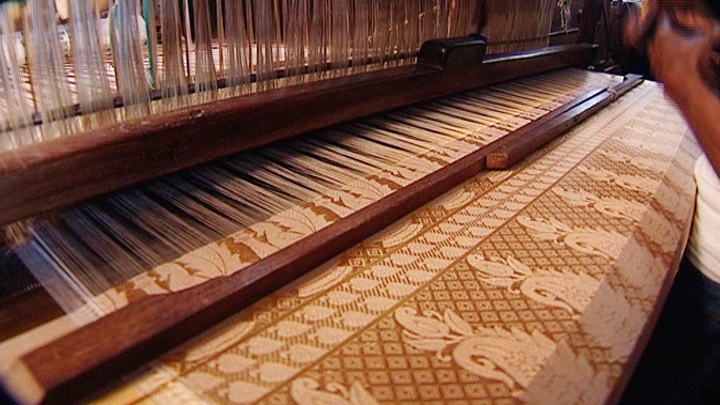What Is Silk...??
Silk broadly seems because of the most highly-priced fabric in the world. its tumultuous history, rife with wars, secrecy, and centuries of alternate, bears little resemblance to the fabric's current recognition for being the epitome of excessive fashion.
the maximum abundant shape of silk, a herbal protein fiber, is cultivated from the cocoon of mulberry silkworm larvae. silkworms lay eggs on unique paper and eat handiest fresh mulberry leaves. thirty-5 days after hatching, the silkworms begin spinning their cocoons. each cocoon yields 1,000 yards of uncooked silk thread, that is then spun to produce a “yarn” of silk. the method is time-ingesting and delicate, which explains the high value of silk. the fiber receives its first-rate shimmer from its shape, a triangular prism that displays mild at various angles. some other version of silk, “wild silk”, is produced by means of caterpillars other than the mulberry silkworm, and may be harvested in captivity just like traditional silk. the shade and texture of untamed silk tends to differ from the cultivated range, and the fibers are commonly shorter, due to harm through the rising moth. to maintain the long, silken strands of fiber in cultivated cocoons, the larvae inner is commonly pierced with a needle, and the cocoon is unraveled without damage.
silk's textile origins date lower back to 6000 bc, whilst the spouse of the yellow emperor, xi ling-shi, went for a walk amongst broken mulberry timber and noticed glistening threads connected to worms consuming the plant's leaves. historians disagree about how long it took earlier than xi ling-shi realized the silkworms cocoons may be harvested into silk, however one model recounts the empress dropping a cocoon into her tea and looking it get to the bottom of into silken threads. china maintained a monopoly on silk change for hundreds of years and orchestrated an tricky and famous alternate gadget ultimately extending as a long way west as europe and africa, which was known as the silk avenue. notable silk becomes additionally produced in thailand, india and eventually western europe, but the cloth wasn't delivered to america until the 17th century; early settlers truly couldn't manage to pay for the expensive cloth. synthetics were later developed instead for the steeply-priced feel of silk material, but they dyed poorly and lacked the shimmering nice of silk's mild-refracting prisms.
today, silk fabrics are popular in each us of a: from indian saris to french couture gowns, it has pervaded all cultures. its low conductivity maintains one heat inside the winter, whilst its splendid absorbency wicks moisture away all through summer season. the feel of silk fabric is unmistakable: smooth and expensive, the material ripples just like the floor of water. this satisfactory makes it specially appropriate for horny lingerie and stylish attire. it's far a material reserved for unique activities, a material intended to beautify a moment.
Silk broadly seems because of the most highly-priced fabric in the world. its tumultuous history, rife with wars, secrecy, and centuries of alternate, bears little resemblance to the fabric's current recognition for being the epitome of excessive fashion.
the maximum abundant shape of silk, a herbal protein fiber, is cultivated from the cocoon of mulberry silkworm larvae. silkworms lay eggs on unique paper and eat handiest fresh mulberry leaves. thirty-5 days after hatching, the silkworms begin spinning their cocoons. each cocoon yields 1,000 yards of uncooked silk thread, that is then spun to produce a “yarn” of silk. the method is time-ingesting and delicate, which explains the high value of silk. the fiber receives its first-rate shimmer from its shape, a triangular prism that displays mild at various angles. some other version of silk, “wild silk”, is produced by means of caterpillars other than the mulberry silkworm, and may be harvested in captivity just like traditional silk. the shade and texture of untamed silk tends to differ from the cultivated range, and the fibers are commonly shorter, due to harm through the rising moth. to maintain the long, silken strands of fiber in cultivated cocoons, the larvae inner is commonly pierced with a needle, and the cocoon is unraveled without damage.
silk's textile origins date lower back to 6000 bc, whilst the spouse of the yellow emperor, xi ling-shi, went for a walk amongst broken mulberry timber and noticed glistening threads connected to worms consuming the plant's leaves. historians disagree about how long it took earlier than xi ling-shi realized the silkworms cocoons may be harvested into silk, however one model recounts the empress dropping a cocoon into her tea and looking it get to the bottom of into silken threads. china maintained a monopoly on silk change for hundreds of years and orchestrated an tricky and famous alternate gadget ultimately extending as a long way west as europe and africa, which was known as the silk avenue. notable silk becomes additionally produced in thailand, india and eventually western europe, but the cloth wasn't delivered to america until the 17th century; early settlers truly couldn't manage to pay for the expensive cloth. synthetics were later developed instead for the steeply-priced feel of silk material, but they dyed poorly and lacked the shimmering nice of silk's mild-refracting prisms.
today, silk fabrics are popular in each us of a: from indian saris to french couture gowns, it has pervaded all cultures. its low conductivity maintains one heat inside the winter, whilst its splendid absorbency wicks moisture away all through summer season. the feel of silk fabric is unmistakable: smooth and expensive, the material ripples just like the floor of water. this satisfactory makes it specially appropriate for horny lingerie and stylish attire. it's far a material reserved for unique activities, a material intended to beautify a moment.


No comments:
Post a Comment